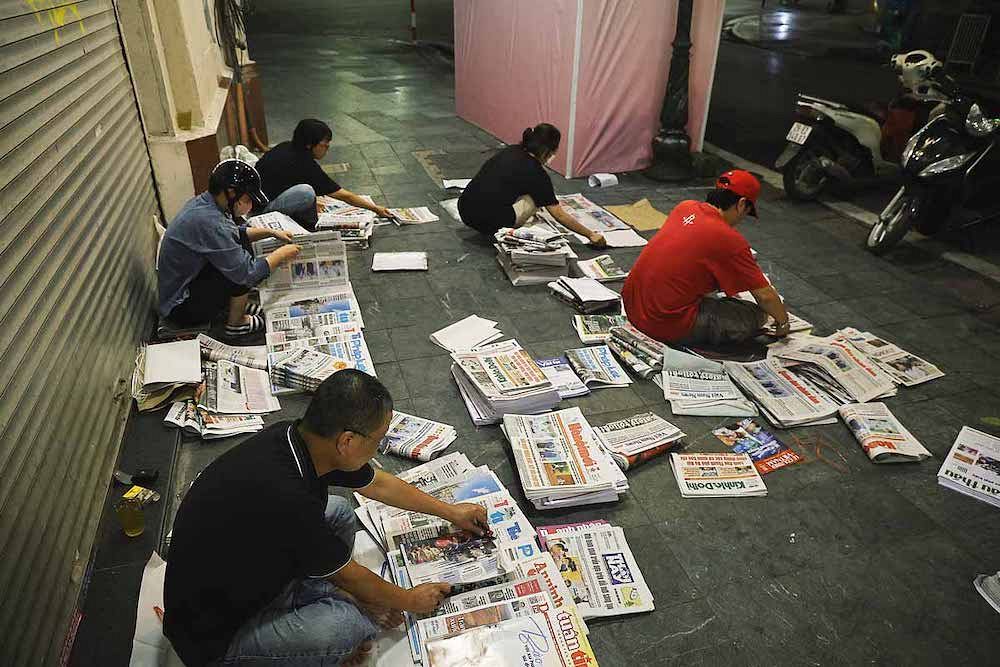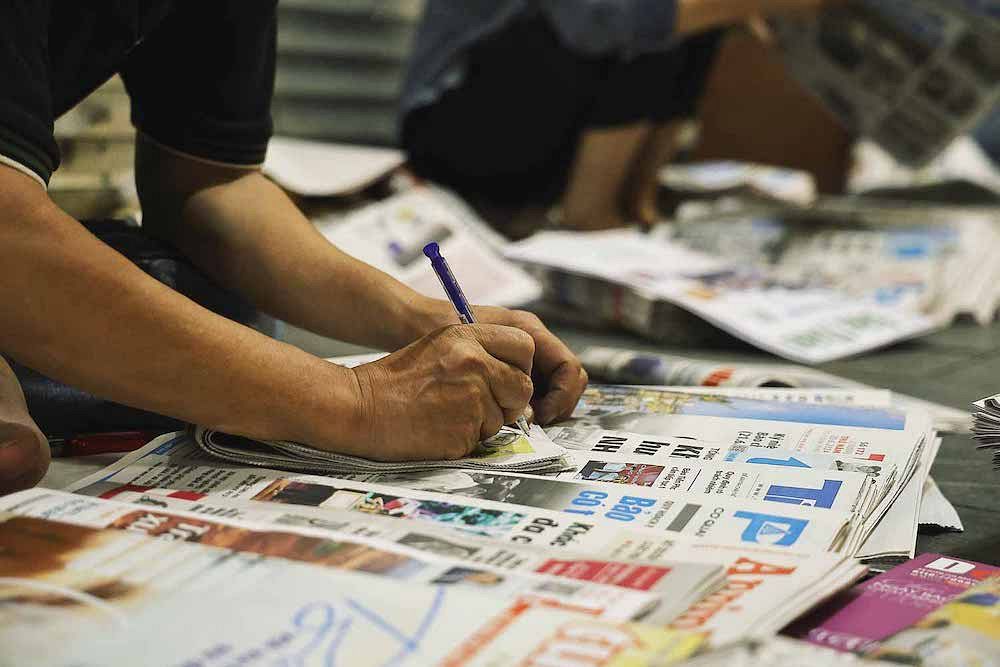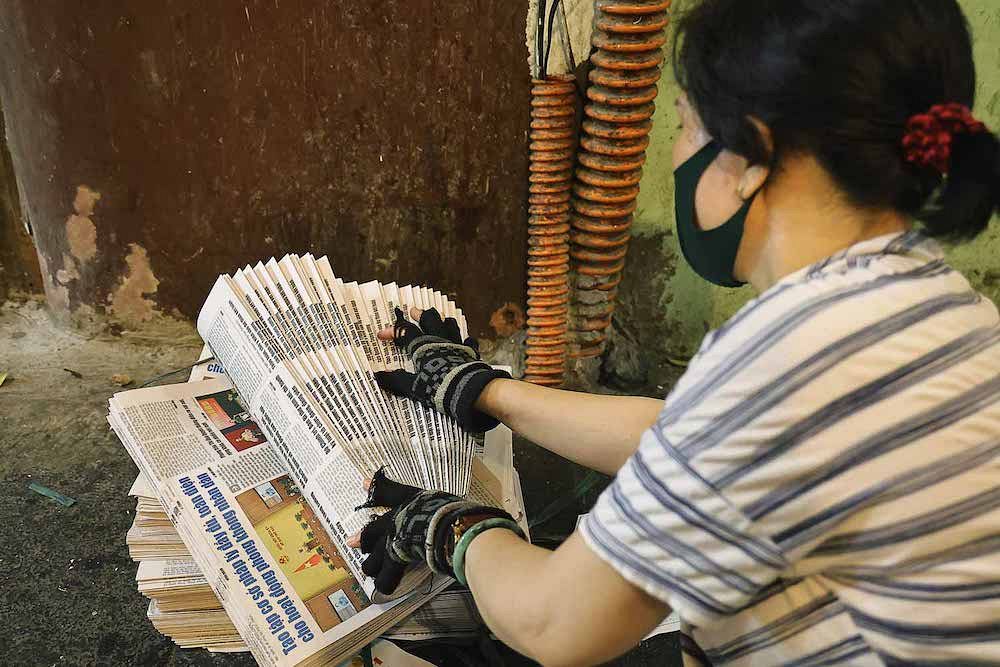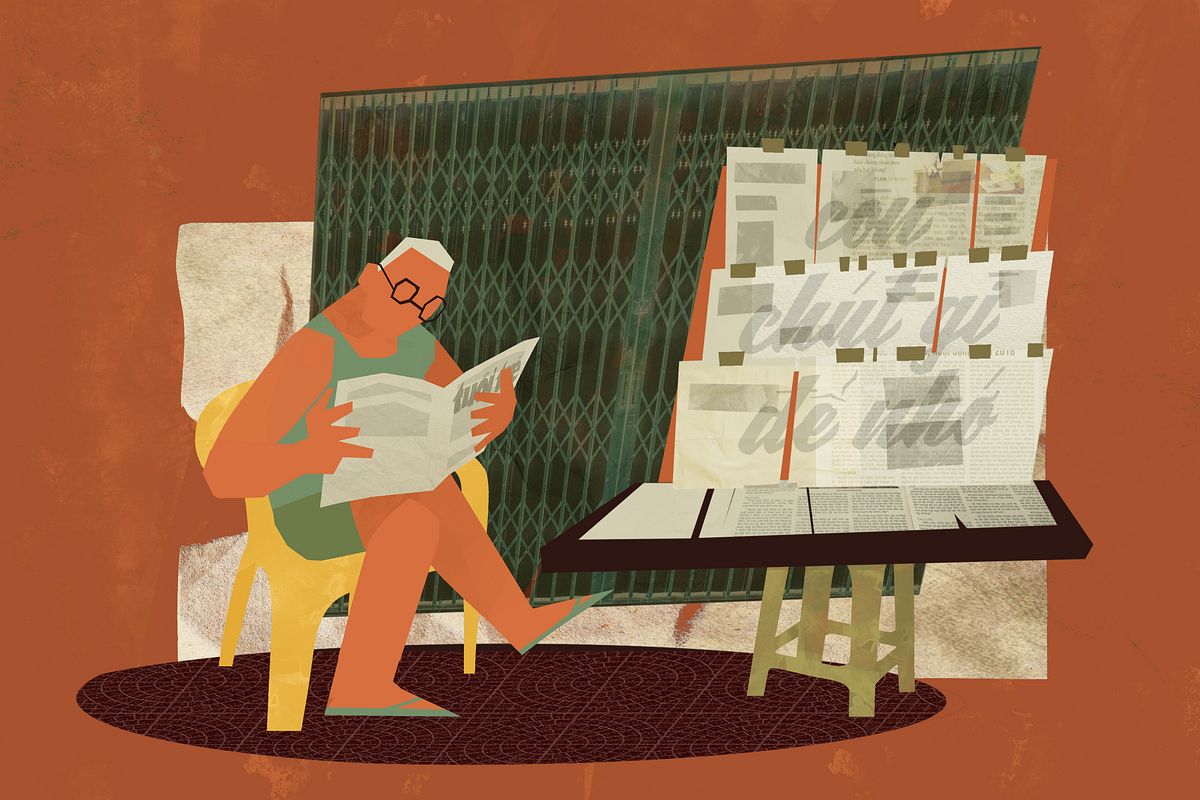Print media was a crucial part of my childhood and a friend that opened a window into a vivid world of knowledge that was fascinatingly strange in the eyes of young me. But right at this moment when I hit the streets as an adult, the newspaper vendors of those days seem to have vanished, their colorful spread of magazines gone amid the busyness of today. A quiet transformation and farewell has begun.
Facing the pressures of time, print media is increasingly absent in our daily life: disappeared from the backpacks of students and office workers, rarely seen at morning coffee tables both in- and outside the house, and retreated to the tiny kiosks at street corners to continue catering to a handful of loyal readers.
A brief history of print media in Vietnam
News production in Vietnam has been on an arduous journey with numerous changes and upheavals. Before 1975, news agencies mainly served the state, transmitting official dispatches, propaganda, and public service announcements to the people. During this era, print media was limited in its quantity and reach. After 1975, it flourished into one of the main media channels connecting Vietnamese from all regions of the country. Newspapers like Tuổi Trẻ (Youth), Thanh Niên (Young Adult), Phụ Nữ (Women), Công An Nhân Dân (The People’s Police) are not just sources of information, but also lively forums for cultural and societal discussions.

A newsstand at the corner of Tự Do-Nguyễn Văn Thinh (now Đồng Khởi-Mạc Thị Bưởi) streets in 1969. Photo by Brian Wickham.
Once upon a time, print media seeped into every nook and cranny of the country alongside the rucksacks of news sellers. Every morning, Vietnamese of all ages pored over still-warm pages in pavement cafes or even on their bikes parked right next to newsstands.
Alas, with the arrival of the 2010s during the explosion of the internet, print’s reign was gradually chipped away, until only a few news kiosks and vendors remained.
Print media in my memory
My formative years were the 2000s, when print was still the predominant source of information, especially in far-flung provinces like Bạc Liêu, my hometown. In a locality where life was generally slower, media platforms like TV, radio, print, and the internet coexisted, but print still played an important role in bringing current affairs to locals.
The newspapers that I bought back then all undertook an extended trip of nearly 300 kilometers from Saigon to Bạc Liêu by coach every early morning. They would first arrive at a wholesaler’s, who matched the front cover with the inside pages, before being distributed by mobile vendors all over town. This was why readers where I lived could only get their daily paper fix at noon or early afternoon.




Traditional newspaper wholesales start sorting before sunrise, and each newspaper must be matched by hand. Photo via Lao Động.
At the time, my brother often bought Mực Tím (Purple Ink), a weekly magazine for teens, from an elderly vendor. He used to teach before 1975, and switched to doing admin tasks for a co-op after. Once the co-op was disbanded, he started making a living by selling lottery tickets and newspapers on his bike. Every day, he carried a huge bag on his chest and biked for 30 kilometers to deliver newspapers to regular customers.
Once, when he stopped by our home to deliver the weekly Mực Tím, I spotted an issue of Nhi Đồng (Children) in his bag, standing out thanks to a colorful cover. Since then, I would wait by our door every Monday for the sound of his bike, looking forward to his figure appearing in our yard to deliver our weekly reads.

Colorful teen magazine of the 2000s. Photo via Phụ nữ Việt Nam.
I was beyond elated the first time I got my hands on that issue of Nhi Đồng. In front of me were cheerful child models and stylized headlines, prompting me to quickly leaf through the magazine for the week’s most fascinating columns, like short stories and quizzes. It felt like having a fresh secret to uncover every week — a new sense of anticipation to be fulfilled. And sometimes, I would sneakily smash my face into the pages and breathe in a lungful of that inviting scent of paper and ink, even though my mother had explicitly forbidden me many times before in fear of germs from the printer.
Over the years, I managed to convince my parents to let me subscribe to a slew of other publications like the daily Tuổi Trẻ and Thanh Niên, the weekly Tuổi Trẻ Cuối Tuần and Tuổi Trẻ Cười, and the special editions of Nhi Đồng and Mực Tím, etc. These less frequent publications often explored specific topics in a deeper way, while the daily versions usually arrived in my hands too late, after I had already learnt about the day’s news on TV.
I enjoyed buying and reading print media. On free afternoons at home, I would sit at my desk with an issue of Tuổi Trẻ in front of me and start reading out loud one article after another, while trying to mimic the diction of TV news anchors as if I were leading the evening news.
After a while, my connection with print newspapers was severed as our news vendor stopped delivering due to poor health. His adult children all settled elsewhere in the country, so there wasn’t anyone in his household to take over the family trade.
A reunion with an old friend
While in university, buying newspapers was no longer something I did often, even though they remained in my life — on the hands of our campus security guard or right on the wooden hangers of our library. I was always drawn to them whenever we crossed paths; I would pick one up and marvel at the pretty pictures and neat blocks of text on the glossy paper surface.
When I started working, I got a Wave motorbike, which opened up ample opportunities to explore Saigon by myself. Here and there, during my trips meandering the city alleys, I would come across a streetside magazine stand with its mosaic of covers, just as enthralling to me as ever. One time after I got off work, I stopped by the small stand on Phạm Ngọc Thạch Street, right in front of the HCMC University of Economics. That was where chú Hùng made a living.

Chú Hùng’s kiosk on Phạm Ngọc Thạch Street. Photo via Phụ Nữ.
Chú Hùng’s newsstand is not terribly large, made up of just a few stacks of magazines pushed together. Still, its display — a kaleidoscope of newspaper covers and his measured, relaxed manner — had an inexplicable charm in the eyes of passersby. Perhaps it was the way it was a placid foil to its hectic environs: a clamorous main street filled with hurried people and lined by flashy shopfronts.
He told me that Phạm Ngọc Thạch was once bustling with numerous newsstands catering to endless throngs of customers. Gradually, after 25 years in the trade, he was the only one left. His income also deflated due to dwindling readership, but he held fast to the kiosk as he has gotten used to the freedom and flexibility it afforded him. Luckily, even though the fate of print media is grim now, he’s still serving a number of regulars from different age groups. A few senior customers still stop by in the early morning to grab their favorite newspapers. A plethora of students from nearby universities like the HCMC University of Architecture would seek him out to buy magazines on fashion, design or visual arts for their academic needs. Others rely on him for certain rarer specialist publications.
After our chat, I decided to get a few issues to support him, all from familiar titles whose print editions I haven’t touched for years — some are kids’ magazines, a satirical comic, and one weekly magazine that I’ve never seen before, Phụ Nữ Chủ Nhật.

Though the market for print media is no longer as lucrative, chú Hùng is still hanging on. Photo via Thanh Niên.
At chú Hùng’s kiosk, my “childhood friends” still wear the same outfit, so I could recognize them immediately. The logos, paper dimensions, and color palettes are still the same after all these years, but inside, things have changed a lot: the children’s magazines used to print only a few pages in color, but now are all colored; the satirical magazine was once printed on thin, flaky paper, but has now changed to a glossy stock. The columns are still presented and arranged neatly, but their content now seems strangely distant to me.
The last magazine in my haul was a weekly special edition of Phụ Nữ newspaper, released on Sundays. Reading through every article, I could sense the authors’ progressiveness and dynamism, and their passion for building a home for in-depth, meaningful discussions. Every publication has its own tone of voice, and that of Phụ Nữ Chủ Nhật is assertive, open-minded, and steely in the face of societal hurdles and dated norms as it advocates for the pursuit of happiness and equality in our community.
I was on cloud nine thinking that I'd found a fantastic read with a distinctive voice, enough to draw me to chú Hùng’s kiosk every week — until I arrived at the penultimate page. There was an announcement that the publication would cease from January 2025. The letter from the editorial team didn’t go into specifics as to why they decided to stop after 28 years in the business and reaching 50,000 copies per issue.

Many long-enduring magazines have stopped enduring. Photo via Phụ Nữ Chủ Nhật.
At that moment, I realized that our encounter had happened too late; before I could celebrate, it had already gone.
In remembrance of newspapers past
Two weeks later, I showed up at chú Hùng’s again to get for myself that last-ever Phụ Nữ Chủ Nhật issue, but he regretfully told me that he stopped stocking the title after the announcement. I called the distributor and was directed to the paper’s headquarters on Điện Biên Phủ Street. Fortunately, there were still a few left. The editorial team dedicated page 3 of the last issue for the goodbye letter, written very affectionately and assertively:
“It was inevitable. How could any of us escape from the cycle of the universe? To reduce ourselves to cinders to return with a new self that’s fresher, better is a feat worth undergoing. Isn’t our most challenging task, especially us women, to leave behind bad habits and overcome hurdles? [...] We’d like to say goodbye with the sincerest gratitude to our beloved readers and hardworking collaborators, who have brought to the table so many interesting, meaningful, and thoughtful articles. We firmly believe that we will meet again, just to recognize and love one another as we used to.”

Once in print, papers can’t immediately change their content, so they serve an important role as witnesses of history. Photo via Lao Động.
That farewell letter reminded me of how I first started reading print media. To a child of a provincial town, newspapers and magazines were the most valuable source of information I could get my hands on. They were my windows to the big wild world out there, unveiling the events happening beyond my tiny town, things that at times I couldn’t quite fully understand, but have helped me learn about the interesting complexities of our society. Those papers nurtured my soul, and have no doubt inspired me in my own endeavors in writing today.
In print, once the newspapers have appeared in the flesh, it’s impossible to modify what’s on the page like the way online media can. This limitation, however, contributes to the invaluable role of print media as a witness to the historical episodes taking place at the time it was printed.
“I don’t think the newspapers will vanish right away,” chú Hùng shared with me. “But they will slowly dwindle.” A river will not evaporate in the blink of an eye, because the water will find ways to fit into tiny creeks. Print media is perhaps similar to that drying river. It will keep at that flow, telling stories to the few regular readers, and perhaps, gaining new readers like me and Phụ Nữ Chủ Nhật.

A xe ôm driver reads a newspaper in the morning in Mỹ Tho City. Photo via Báo Ấp Bắc.
While many newspaper vendors might feel a sense of inevitable sadness and acceptance about our state of print publication, some magazines are returning and changing to adapt to the conditions of today. Tomorrow is a mystery, but there’s one thing I am sure of: whenever I pass by chú Hùng or any other news kiosk on the street, I will make sure to stop by to get a copy for myself.

















